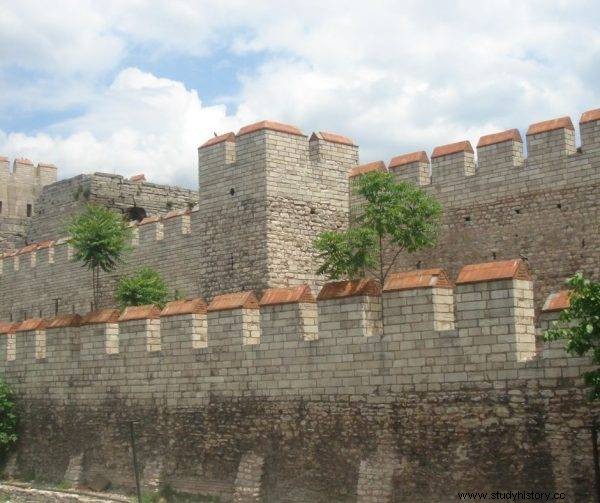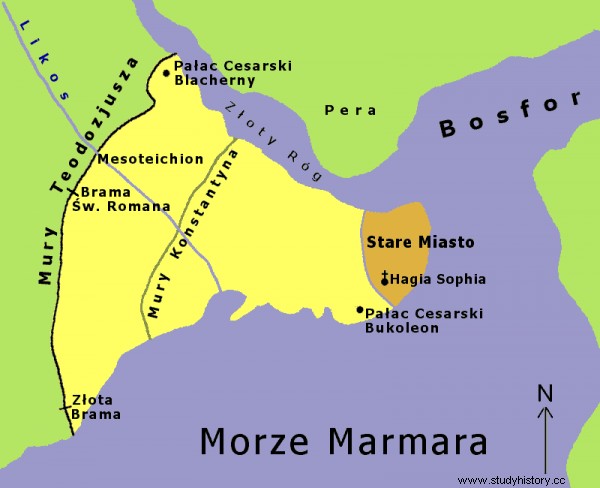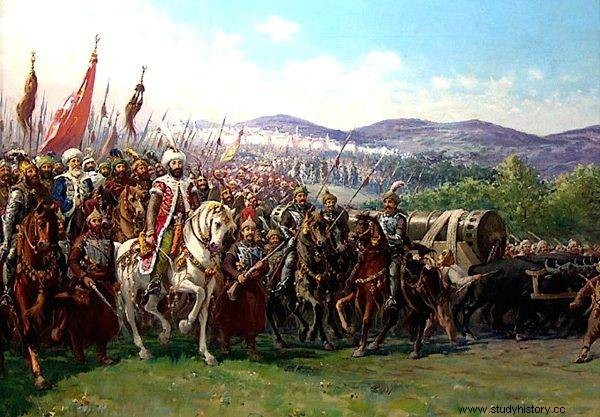The Sultan was well aware of the seriousness of the moment when he pushed his best troops into the attack. Janissaries were breaking into the fortifications, where the swords of Christian defenders awaited them. Many died and even more lost their raised hands to the Queen of Cities as they grasped the edge of the fortifications. After a long time, the Turkish pressure began to weaken. The terrible night was ending, and another day began to wake up over the blood-stained walls - on May 29, 1453. The day when the guns were to decide everything again ...
For centuries, the mighty walls of Constantinople were the last line of defense against Islam. However, when successive waves of the Ottoman army began to crash against its fortifications in the 15th century, the then bulwark of Christianity stood over the abyss. Left to their own fate by Western European rulers, it only counted the days to make the final step towards its destiny and fulfill its gloomy prophecy.
For in the last years of the empire's existence, when it was only a shadow of an old power limited to the areas around the city, a narrow strip of the Black Sea coast, a few islands and a remote province in the Peloponnese, a bloodcurdling prophecy circulated among its inhabitants. It proclaimed that when the emperor named Constantine became the ruler, the walls of New Rome would collapse under the pressure of the infidels.
Pale fear must have fallen upon the Byzantines in January 1449, when another basileus was the brother of the deceased John VIII - Constantine. The black vision of the future of the city and the country seemed to be coming true.
Glory to the past
However, hope for survival continued to lie in the mighty walls. This, as confirmed by military historians, the miracle of engineering thought at the turn of antiquity and the Middle Ages seemed impossible to overcome. For he was able to withstand practically anything that a man could devise to conquer fortifications at the time.
Even the best siege machines had to recognize the superiority of the huge fortifications stretching for almost 20 kilometers, perfectly integrated into the natural defensive values of the city located on the peninsula. Persians, Avars, Slavs, Arabs, Bulgarians, Ruthenians and Pechenegs tried to conquer them. Out of more than 20 such attempts throughout history, only two have been successful - in 1204 and 1261. However, it was not so much the aggressors' skills that decided that, but the internal conflicts of the defenders.
The Turks themselves also tried to conquer Constantinople many times. Most often, however, they were blockades - apart from a siege and a real assault in 1422.

A reconstructed fragment of Theodosius' Walls at the Selymbria gate
The subsequent attacks that ended in failure only strengthened the faith in God's protection in the Byzantines. It must have been obvious to them that, since so many Christian relics have been gathered in Constantinople, the true faith is professed there with great fervor, and all barbarians, heretics and pagans have been defeated so many times under its walls, the Imperial City must indeed enjoy the special favor of Providence. As the researchers of the subject emphasize, perhaps this was the reason for the belief that as long as Constantinople exists as the capital of the Empire, the world does exist.
It was still alive in the middle of the 15th century, when Constantinople looked little like the metropolis of its heyday. Although it occupied a huge area, only about 100,000 people lived there. people, which, compared to the former million, clearly shows his weakness. The vast majority of farms were pastures and settlements, which were practically independent organisms.
The chronicles mention numerous ruins and the poverty of the inhabitants. The imperial palace, which was even stripped of lead off the roof, and the magnificent hippodrome in ruins, must have made a gloomy impression on visitors. Yes, in many parts of the city there were still enclaves of prosperity, the temple of God's Wisdom continued to make an amazing impression, and the cultural and intellectual life continued to develop. All this, however, could not conceal the fact that the city and the empire are in a deep crisis.
The empty treasury, the lack of agreement with Rome regarding the ecclesiastical union and the increasingly felt iron grip of the Ottoman state completed the dread of the situation. And there was no indication that this would change. Especially when Mehmed II, hungry for fame, ascended the sultan's throne in 1451.
Who needs this Constantinople?
It is worth noting that the only 19-year-old Sultan initially made a good impression on the deputies who came to him with the usual wishes for successful governments from various parts of Europe. He renewed alliances, signed treaties, and made business contacts. Before the Byzantine envoys, he swore by Allah and the Koran that he would remain peacefully with Emperor Constantine for the rest of his life.
However, when in April 1452 at the mouth of the Bosphorus he began building a fortress with the emphatic name of Boğazkesen - Slitting Throat - it became clear that this was the beginning of the war . Interestingly, to basileus it didn't seem to be getting through. For he had sent a message to Mehmed, wishing to make sure that the fortress would not be a threat to Byzantium. The sultan's answer was clear and precise - he ordered the imperial envoys to be beheaded.
Why, however, weak and stripped of its splendor, Constantinople was a spoil for Mehmed so valuable that he spared no means to prepare for his conquest? As emphasized by experts on the subject, the most important - apart from economic issues (this is where the trade routes between the East and the West crossed) - was probably the power of the symbol.

The "Rise of Empires:The Ottomans" series. Premiere:on weekdays from Monday, February 15 at 21:55 on the Polsat Viasat History channel
The new Rome could only belong to the most powerful ruler. His possession meant absolute power over all lands of the then world, sovereignty over each of the kings . The young sultan wanted to be the one who would fulfill the Koranic order for the followers of Muhammad to seize all the land. He dreamed that it was he who would stick the green banner of the prophet on the walls of Byzantium.
The conquest of the city was to solve Mehmed's problems with the internal opposition, headed by the grand vizier of Hala Pasha. This conservative and cautious opponent of armed confrontation posed a threat not only because of his proficiency in political intrigues, but also because of the respect that the soldiers of the elite Janissary corps had for him. Mehmed understood perfectly well that the conquest of Constantinople would provide him with a government of souls in an extremely important instrument of power in the state - the army.
Young technician
While getting ready to settle the issue of supremacy in the world at that time, the Sultan did not neglect anything. At the expense of almost all the funds at his disposal, he deployed an army of nearly 160,000 and a war fleet of almost 150 units.
The Byzantine walls were what kept him awake in the first place. If the Turkish ruler were forced to use only known technical means such as catapults, ballistae, siege towers or fortification bits, the success of his mighty army could be called into question.
Mehmed was, however, not only a son of Islam, a power-hungry son, but also an educated man, familiar with European culture, familiar with the deeds of Achilles and Alexander the Great, speaking five languages, and most importantly, knowledgeable about war and technology - especially artillery. He is even credited with inventing a new long-range mortar, which was used during the siege of Constantinople.
In Western Europe, gunpowder artillery has been in use for a hundred years - and it was mainly from there that the Sultan learned about it and watched technical innovations. The custom of trading in arms and war materials with European (mainly Italian) merchants was not without significance here.
Due to the fact that the purchased weapons were used mainly to fight Christians, and the practice itself took on a huge scale, Pope Gregory XI even banned them from supplying "Saracens and other enemies of Christianity" . However, although the execution of the papal ban was carried out by the Rhodian Hospitallers, the contraband profitable for both sides was still doing very well. Mercenary artillerymen and bell founders also followed the same route. Among them was one who was to play a significant role in the history of the impending conflict.
Urban Basilica
Although in the sixteenth century no army could compete with the Turks in the number of guns and the level of training of their service, they still could not cast large-caliber cannons, and such were needed to overcome the mighty walls of Constantinople. The largest Turkish cannons were mostly made of wrought iron or bronze sheets held together by hoops - the weapon a bit outdated, even for the conditions of the time.
Fate ruled that in the summer of 1452 a bell-founder named Urban came to the City of Cities, probably from Hungary. He proposed to Constantine XI to pour a high-quality cannon to defend the city. The emperor expressed interest in his offer, but the terrible state of the state treasury did not allow for its implementation. Moreover, the ruler was not even able to provide the necessary raw material.
In this situation, the Hungarian bell founder, as an entrepreneur professing the cult of the full purse, offered his services to ... the Sultan. The young ruler only seemed to be waiting for such an opportunity . And when Urban assured him that he could construct a cannon capable of destroying "the walls of Babylon," he offered him a wage four times the Emperor's proposed, comfortable working conditions and the highest quality materials needed.
Urban so motivated in three months, he created a cannon capable of throwing 272 kg cannons, which the Sultan placed on the walls of the newly erected Boğazkesen fortress. Soon, the new acquisition proved its effectiveness, melting the Venetian galley trying to break the blockade of Constantinople introduced in March 1453.
At the same time, at the foundry in Edirne, then the capital of the Ottoman state, work was underway on an even larger cannon. When they were completed, the observers saw a real miracle of bell foundry. The new gun probably weighed about 19 tons and was 8 meters long. Its caliber probably ranged from 750 to 850 millimeters . At that time, however, the measure of the power of the gun was the weight of the bullets fired, and this was unimaginable - half a ton.
As soon as the Basilica - as the monster was called because of its size - was ready, a fire test was carried out in the vicinity of the Sultan's Palace. The effect surpassed all expectations. The bullet, launched with a bang in a radius of several kilometers, after a kilometer and a half flight, struck the ground with a thud to a depth of 2 meters.

The cannon was pulled by 60 oxen and prevented from overturning by 200 men
The Risen Mehmed immediately ordered the Basilica and the rest of the smaller guns (it was supposed to have nearly 70 in total) transported to Constantinople. Several hundred people were sent ahead to level the road leading to the city and strengthen the bridges and crossings. Then, pulled by 60 oxen and secured against overturning by 200 men, Urban's work of life began. The journey was arduous, as it took 2 months to travel from Edirne to the Byzantine walls of about 180 kilometers.
The Sultan realized that the expedition against the Queen of Cities was a game of everything. After all, he devoted state resources to it and boldly announced the transfer of his state capital from Edirne to Constantinople. So there was no turning back. So when on April 6, 1453, the Basilica spat the first horrible boulder towards the rampart of Christianity, Mehmed already knew that the acts must decide everything.
Bibliography
- Babinger F., From the history of the Ottoman Empire . Sultan Mehmed the Conqueror and his times , crowd. T. Zabłudowski, Warsaw 1977.
- Billings M., Crusades , crowd. Z. Dalewski, Warsaw 2002.
- Crowley R., 1453 Fall of Constantinople , crowd. A. Weseli-Ginter, Warsaw 2006.
- Derdej P., Constantinople May 29, 1453 , Zabrze – Tarnowskie Góry 2015.
- Długosz J.M., This is how Byzantium fell 560 years ago , https://www.polityka.pl/tygodnikpolityka/historia/1544269,1,tak-upadalo-bizancjum-560-lat-temu.read [access:3 February 2021].
- Idzik J., Lead hail:an outline of the history of artillery development to the pre-Napoleonic times , https://studiadesecuritate.up.krakow.pl/wp-content/uploads/sites/43/2018/12/3.pdf [access:6.02.2021].
- Constantinople. New Rome:City and People in the Early Byzantine Period , ed. M.J. Leszki and T. Wolińska, Warsaw 2011.
- Michałek A., Crusades. The armies of the Turkish peoples , Warsaw 2001.
- Michałek A., Crusades. Mehmed the Conqueror , Warsaw 2003.
- Nicol M.D., Constantine XI - the last emperor of Byzantium , crowd. M. Dąbrowska, Gdańsk 2004.
- Nicolle D., Fall of Constantinople 1453 , crowd. M. Krawczyk, Poznań 2011.
- Nicolle D., Haldon J., Turnbull S., Fall of Constantinople , crowd. J. Jackowicz, Warsaw 2010.
- Runciman S., Going on Crusades , vol. 1–3, trans. J. Schwakopf, Warsaw 1987.
- Runciman S., Fall of Constantinople , crowd. A. Dębnicki, Warsaw 1994.
- Witasek M., Constantinople 1453 , Warsaw 2008.
